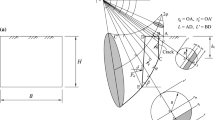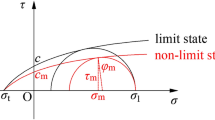Abstract
A new simplified formulation is suggested to determine active earth pressure against a retaining wall undergoing rotation about the base in the cohesive-frictional soil based on the limit equilibrium method. It takes into account the effect of the cohesion, unit weight, and wall height for the rupture angle and angle of the reaction force. The accuracy of the proposed method is checked by comparing the experimental results and other theoretical methods. The comparison results show that the proposed method is appropriate for predicting the distribution of active earth pressure and the rupture angle in the cohesive-frictional soil with rotational displacement. Additionally, a simplified formulation was derived to predict the depth of tension cracks in the backfill considering the influence of the soil-wall interface friction angle, rupture angle, rotational displacement, and wall height. A parametric study was undertaken to access the effects of the wall height, cohesion, internal friction angle, and soil-wall interface friction angle on the rupture angle and tension cracks by the proposed method and numerical method. The results show that the rupture angle and tension cracks is closely related to the wall height.












Similar content being viewed by others
Data availability
All data generated or analyzed during this study are included within the article.
Abbreviations
- H :
-
height of retaining wall
- s :
-
top displacement of retaining wall
- z :
-
depth of tension cracks
- b :
-
width of the tension cracks zone
- h :
-
depth of retaining wall
- β :
-
angle between slip surface and horizontal plate
- ε :
-
angle of inclination of retaining wall
- γ :
-
unit weight
- c :
-
cohesion strengths
- φ :
-
internal friction angle
- α :
-
the angle between the reaction force (R) and normal BC plane
- δ :
-
soil-wall interface friction angle
- ψ :
-
angle between force G and Q
- λ 1, λ 2 :
-
coefficient
- G :
-
weight of slip wedge (EBCD)
- R :
-
reaction resultant forces
- Q :
-
total lateral earth pressure
- T 1, T 2 :
-
shear force along the BC and AB plane
- N 1, N 2 :
-
normal forces of the contact surface
- p a :
-
active earth pressure
- p am :
-
lateral earth pressure
References
Arora KR (2004) Soil mechanics and foundation engineering (Sixth Edition). Lomus Offset Press:478–514
Bang S (1985) Active earth pressure behind retaining walls. J Geotech Eng 111(3):407–412
Chang MF (1997) Lateral earth pressures behind rotating walls. Can Geotech J 46:498–509
Rao PP, Chen QS, Zhou YT, Nimbalkar S, Chiaro G (2016) Determination of active earth pressure on rigid retaining wall considering archingeffect in cohesive backfill soil. International Journal of Geomechanics 16(3):04015082
Clough GW, Duncan JM (1971) Finite element analysis of retaining wall behavior. J Geotech Eng 97(12):1657–1673
Coulomb (1776) C.A: Essias sur une application des maximis et minimis a quelques problems de statique relatits a larchitecture. Mémoires de l’Académie Royale des Sciences presents par divers Savans, Paris 5, 7.
Fan CC, Fang YS (2010) Numerical solution of active earth pressures on rigid retaining walls built near rock faces. Comput Geotech 37(7-8):1023–1029. https://doi.org/10.1016/j.compgeo.2010.08.004
Fang YS, Ishibashi I (1986) Static earth pressure with various wall movements. J Geotech Geoenviron 112(3):317–333
Griffiths DV, Lane PA (1999) Slope stability analysis by finite elements. Géotechnique 49:387–403. https://doi.org/10.1680/geot.1999.49.3.387
Handy LR (1985) The arch in soil arching. J Geotech Eng 111(3):302–318. https://doi.org/10.1061/(asce)0733-9410(1985)111:3(302)
Khosravi MH, Pipatpongsa T, Takemura J (2016) Theoretical analysis of earth pressure against rigid retaining walls under translation mode. Soil and Foundations 54(4):664–675
Kumar SS (2010) Dynamic active thrust from c–φ soil backfills. Soil Dyn Earthq Eng 31(3):526–529
Li MG, Chen JJ, Wang JH (2017) Arching effect on lateral pressure of confined granular material: numerical and theoretical analysis. Granul Matter:1–11. https://doi.org/10.1007/s10035-017-0700-2
Lin H, Cao P, Gong F, Li J, Gui Y (2009) Directly searching method for slip plane and its influential factors based on critical state of slope. J Cent S Univ Technol 16:131–135. https://doi.org/10.1007/s11771−009−0022−6
Liu FQ, Wang JH (2007) A generalized slip line solution to the active earth pressure on circular retaining walls. Comput Geotech 35(2):155–164. https://doi.org/10.1016/j.compgeo.2008.02.002
Liu FQ, Wang JH, Zhang LL (2009) Axi-symmetric active earth pressure obtained by the slip line method with a general tangential stress coefficient. Comput Geotech 36(1-2):352–358. https://doi.org/10.1016/j.compgeo.2008.02.002
Liu M, Chen X, Hu Z, Liu S (2020) Active earth pressure of limited c-φ soil based on improved soil arching effect. Appl Sci 3243:1–17. https://doi.org/10.3390/app10093243
Lu TH (2002) A formula of active earth pressure including cohesion and adhesion. Rock Soil Mech 23(4):170–173
Luan M, Wu Y, Nian T (2003) A criterion for evaluating slope stability based on development of plastic zone by shear strength reduction FEM. J Disaster Prev Mitig Eng 23:1–8
Matsuo M, Kenmochi S, Yagi H (1978) Experimental study on earth pressure of retaining wall by field tests. Soils Found 18(3):27–41
Mazindrani ZH, Ganjal MH (1997) Lateral earth pressure problem of cohesive backfill with inclined surface. J Geotech Geoenviron 123(2):110–112
Mei GX, Chen QM, Song LH (2009) Model for predicting displacement dependent later earth pressure. Can Geotech J 46:969–975
Paik KH, Salgado R (2003) Estimation of active earth pressure against rigid retaining walls considering arching effects. Géotechnique 53(7):643–653
Peng MX, Chen J (2013) Slip-line solution to active earth pressure on retaining walls. Géotechnique 63(12):1008–1019
Rankine WJM (1857) On the stability of loose earth. Philos Trans R SocLond 147:9–27
Tu BX, Jia JQ (2012) Research on active earth pressure behind rigid research wall from clayey backfill considering soil arching effects. Chin J Rock Mech Eng 31(05):1064–1070
Vahedifard F, Leshchinsky BA, Mortezaei K, Lu N (2015) Active earth pressures for unsaturated retaining structures. J Geotech Geoenviron 141(11):04015048. https://doi.org/10.1061/(asce)gt.1943-5606.0001356
Wang Y, Huang J, Tang H (2020) Automatic identification of the critical slip surface of slopes. Eng Geol 273(08):105672. https://doi.org/10.1016/j.enggeo.2020.105672
Xu RQ, Liao B, Wu J, Chang S (2013) Computational method for active earth pressure of cohesive-frictional soil under non-limit state. Rock Soil Mech 34(1):148–154
Ying H, Jiang B, Xie K (2007) Distribution of active earth pressure against retaining walls considering arching effects. Chinese Journal of Geotechnical Engineering 29(5):717–722
Zhao, C.G., Bai, B., 2004. Fundamentals of soil mechanics. Tsinghua University Press and Beijing Jiaotong University Press, 197-290.
Zheng H, Sun G, Liu D (2009) A practical procedure for searching critical slip surfaces of slopes based on the strength reduction technique. Comput Geotech 36:1–5
Zhou YY, Ren ML (1990) An experimental study on active earth pressure behind rigid retaining wall. Chinese Journal of Geotechnical Engineering 12(2):19–26
Zhu, J.M., Zhao, Q., Lin, Q.T., Zhen, J.Y., et al, 2015. Study on calculation Method of soil arch effect. China University of Mining and Technology Press, 1-44.
Acknowledgements
The study was supported by the National Natural Science Foundation of China (Grant 41272333) and National Program on Key Basic Research Project of China (Grant 2011CB013501).
Author information
Authors and Affiliations
Corresponding author
Ethics declarations
Conflict of interest
The authors declare that they have no conflict of interest.
Additional information
Responsible editor: Zeynal Abiddin Erguler
Rights and permissions
About this article
Cite this article
Jiang, J., Zhao, Q., Zhu, S. et al. New procedure for active earth pressure calculation in cohesive-frictional soil. Arab J Geosci 14, 1062 (2021). https://doi.org/10.1007/s12517-021-07381-z
Received:
Accepted:
Published:
DOI: https://doi.org/10.1007/s12517-021-07381-z




